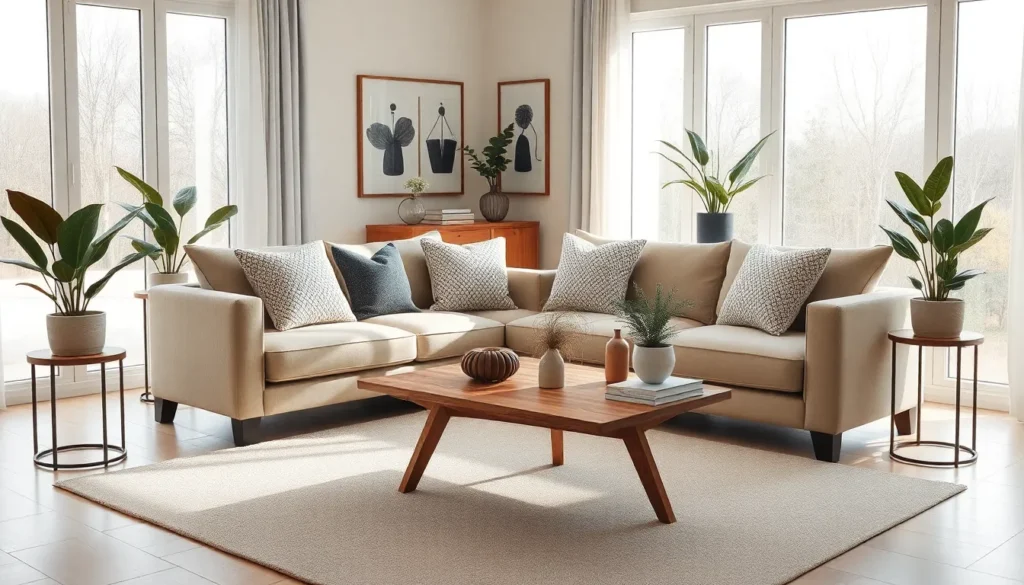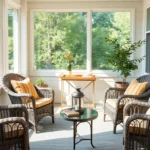Creating a stunning living room doesn’t require bold colors or dramatic design choices. Neutral living rooms offer timeless elegance and versatility that we’ve come to love for their ability to adapt to any style or season. These sophisticated spaces prove that subtle doesn’t mean boring – they’re the perfect canvas for showcasing your personality through textures, patterns, and carefully chosen accents.
We’ve discovered that neutral palettes create the most welcoming and relaxing environments in our homes. From warm beiges and soft grays to crisp whites and earthy tones, these colors work harmoniously to establish a sense of calm while maintaining visual interest. The beauty of neutral design lies in its flexibility – you can easily refresh your space with seasonal decor changes without starting from scratch.
Whether you’re designing your first home or refreshing an existing space, neutral living rooms offer endless possibilities. Let’s explore how to master this effortlessly chic aesthetic that never goes out of style.
Start With a Neutral Color Palette Foundation
Creating a cohesive neutral living room begins with establishing the right color foundation. We’ll explore how to layer different neutral tones to achieve depth and visual interest.
Choose Warm Neutral Tones
Warm neutrals transform living spaces into cozy retreats that feel naturally inviting. Beige, cream, mushroom, and taupe create an embracing atmosphere that welcomes family gatherings and quiet moments alike. We recommend selecting one dominant warm tone for walls and building layers with complementary shades.
Camel colored sofas pair beautifully with ivory walls and oatmeal throw pillows. Warm undertones in paint colors like greige or mushroom provide richness without overwhelming the space. These earthy hues work particularly well in rooms with northern exposure where natural light tends to feel cooler.
Consider incorporating warm wood tones through furniture pieces like walnut coffee tables or honey oak side tables. These natural elements reinforce the cozy foundation while adding texture and organic appeal to your neutral palette.
Incorporate Cool Neutral Shades
Cool neutrals bring sophistication and contemporary elegance to living room designs. Gray, charcoal, dove, and stone create calming environments that feel fresh and modern. We suggest using cool tones strategically to balance warmer elements and prevent the space from feeling too cozy or closed in.
Soft gray walls provide an excellent backdrop for white trim and crisp linen upholstery. Cool undertones in paint selections like pure gray or greige with blue hints add depth while maintaining the neutral aesthetic. These shades work exceptionally well in south facing rooms where warm natural light provides balance.
Stone colored area rugs anchor seating arrangements while introducing subtle texture. Cool toned artwork and accessories like pewter picture frames or silver table lamps enhance the sophisticated atmosphere without disrupting the neutral harmony.
Balance Light and Dark Elements
Strategic contrast prevents neutral living rooms from appearing flat or monotonous. Light elements like white walls and cream furniture create openness while dark accents like charcoal pillows and black picture frames add definition and visual weight. We recommend following the 60 30 10 rule when distributing these tonal variations.
| Element Type | Percentage | Examples |
|---|---|---|
| Dominant Light Tone | 60% | Walls, large furniture pieces |
| Medium Neutral | 30% | Area rugs, window treatments |
| Dark Accents | 10% | Throw pillows, artwork, accessories |
Natural light plays a crucial role in how these contrasts appear throughout the day. Rooms with abundant sunlight can handle darker elements more effectively while spaces with limited natural light benefit from lighter foundations with carefully placed dark accents.
Layering different values of the same neutral family creates subtle depth without jarring transitions. Cream walls with off white furniture and ivory accessories demonstrate this technique while maintaining visual cohesion throughout the space.
Create Visual Interest With Textural Elements
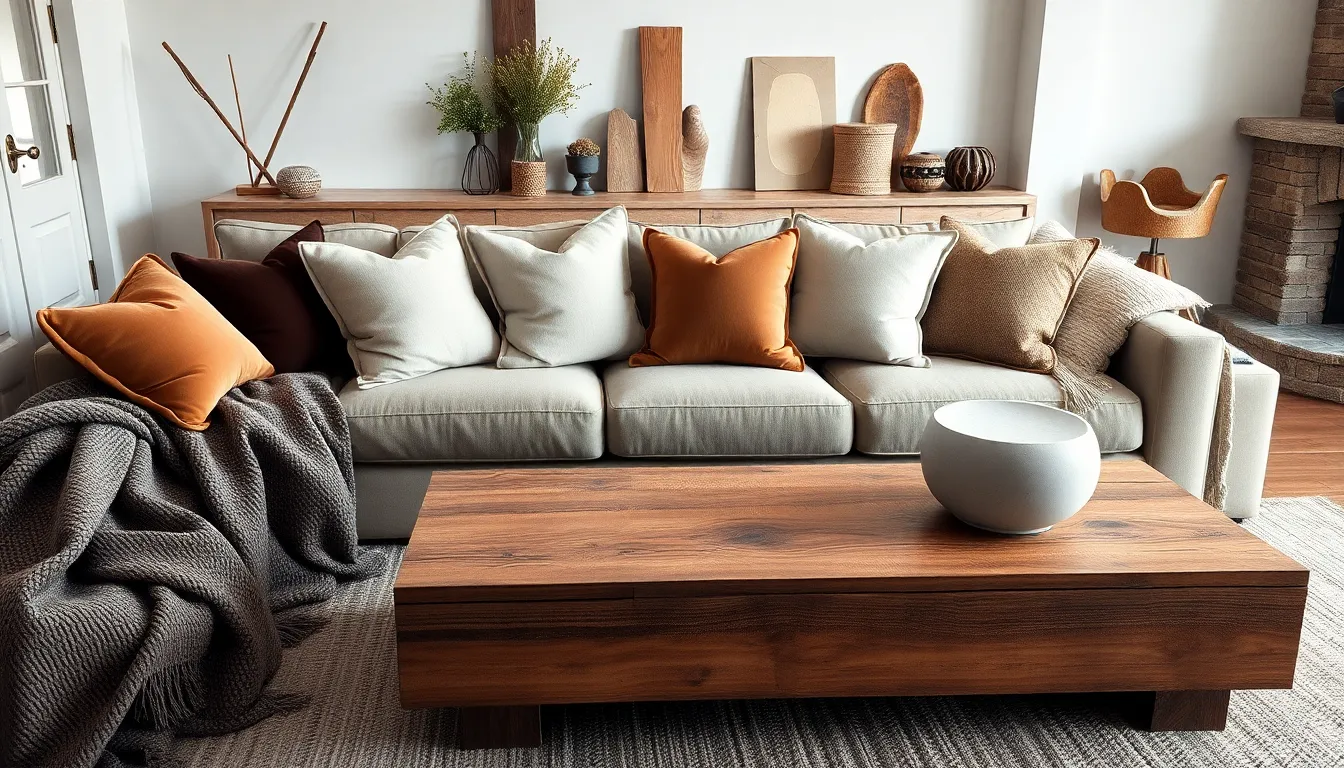
Texture transforms neutral living rooms from flat and boring into ever-changing and captivating spaces. We’ll explore three powerful ways to add depth and visual appeal through strategic textural choices.
Layer Different Fabric Textures
Layering different fabric textures creates depth without overwhelming your neutral color palette. We recommend combining velvet cushions with linen throw pillows to establish contrast between smooth and rough surfaces. Cotton slipcovers paired with wool blankets add another dimension of tactile interest.
Mixing soft and structured fabrics helps define different areas within your living space. Silk curtains flowing alongside jute rugs create an elegant balance between refined and casual elements. Chenille throws draped over leather furniture introduce warmth while maintaining sophistication.
Strategic placement of textural elements maximizes visual impact throughout the room. We suggest positioning a chunky knit throw on your sofa’s arm while placing smooth ceramic accessories nearby. Faux fur pillows scattered among canvas cushions provide inviting contrast that draws the eye.
Add Natural Wood Accents
Natural wood accents bring warmth and organic beauty to neutral living rooms, creating visual interest through grain patterns and natural variations. We recommend incorporating wood through furniture pieces like coffee tables, side tables, or entertainment centers that showcase different wood tones.
Wood paneling or accent walls transform plain neutral backgrounds into striking focal points. Reclaimed barn wood creates rustic texture while sleek walnut panels offer contemporary sophistication. Floating shelves in varying wood tones add both function and visual dimension.
Wooden architectural details enhance the room’s character without dominating the space. We suggest adding wood ceiling beams, window trim, or doorframes that complement your existing neutral palette. These elements create subtle texture while maintaining the room’s cohesive feel.
Include Stone or Concrete Features
Stone or concrete features introduce earthy textures that ground neutral living rooms in natural elements. We recommend incorporating these materials through statement pieces like stone fireplace surrounds or concrete coffee tables that become conversation starters.
Exposed brick or stone walls create dramatic textural backdrops for neutral furnishings. Natural stone adds organic patterns and color variations that complement beige, gray, and cream palettes. Concrete accent walls provide smooth, modern texture that pairs beautifully with soft fabrics.
Smaller stone and concrete accessories offer subtle ways to introduce these textures without major renovations. We suggest adding concrete planters, stone bookends, or marble serving trays that bring natural texture to tabletops and shelving. These pieces create visual anchors throughout your neutral space.
Select Versatile Neutral Furniture Pieces
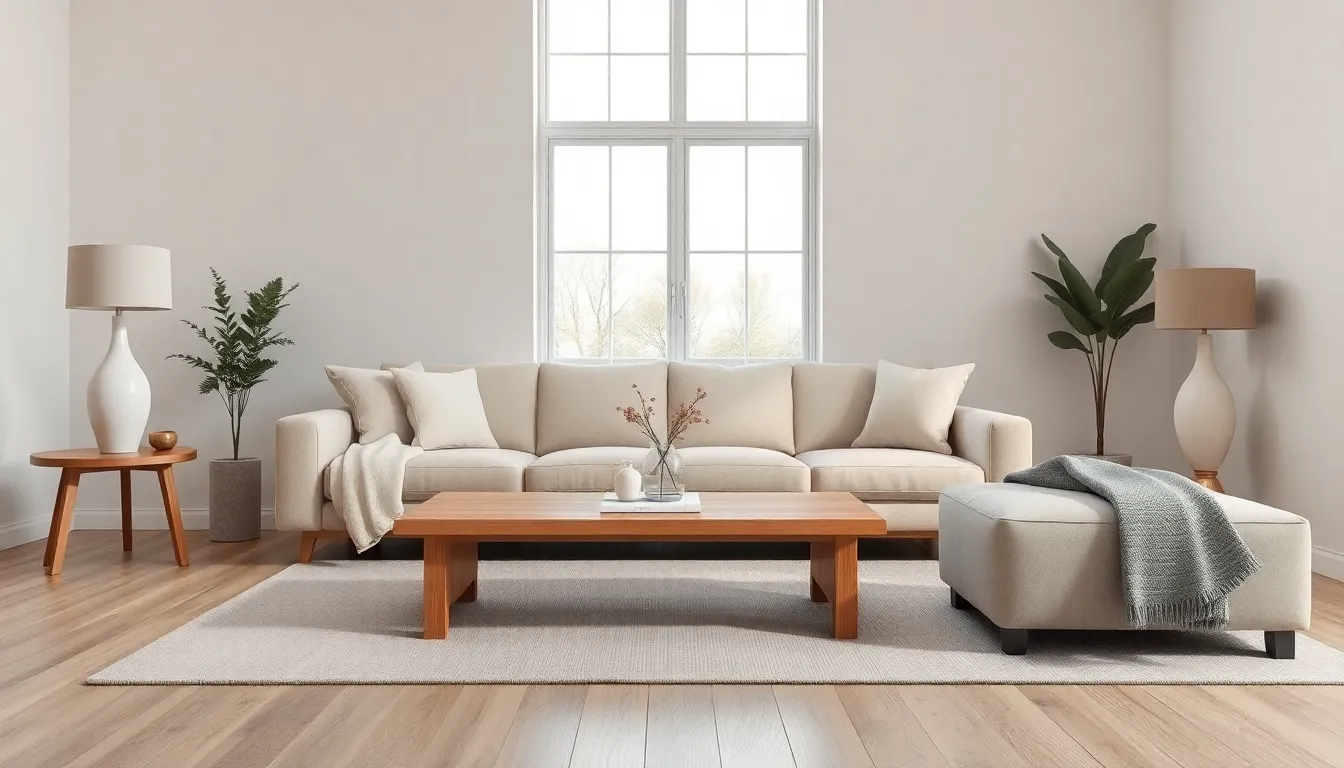
Building upon our textural foundation, we need furniture pieces that seamlessly blend with our neutral palette while offering lasting style and functionality.
Invest in Quality Neutral Sofas
Neutral tones form the cornerstone of versatile living room design. We recommend choosing sofas in white, beige, or gray as these colors complement other furniture pieces effortlessly while maintaining timeless appeal. Quality materials ensure your investment lasts longer and provides the comfort your family deserves.
Comfort shouldn’t be compromised for style. We suggest selecting sofas made from high-quality materials that offer both durability and visual appeal. These neutral-toned pieces serve as anchor points that allow us to experiment with colorful accessories and seasonal decor changes without overwhelming the space.
Choose Multi-Functional Storage Answers
Storage ottomans maximize both function and style in neutral living rooms. We love how these versatile pieces serve as additional seating, footrests, and hidden storage for throw blankets, books, or remote controls. Their neutral upholstery blends seamlessly with our established color palette.
Console tables with built-in storage keep clutter at bay while maintaining clean lines. We find these pieces particularly effective for displaying decorative objects on top while concealing everyday items below. This dual functionality helps us maintain the serene, uncluttered aesthetic that neutral living rooms are known for.
Opt for Timeless Coffee Tables
Natural materials like wood or stone create coffee tables with enduring appeal. We prefer these organic elements because they introduce subtle texture variation while maintaining the neutral color scheme. Wood brings warmth to cooler gray palettes, while stone adds sophisticated weight to lighter beige schemes.
Simple designs fit well with various decorating styles and remain stylish over time. We choose coffee tables with clean lines and minimal ornamentation to ensure they won’t look dated as trends change. These understated pieces allow our textural elements and carefully chosen accessories to take center stage.
Add Depth Through Strategic Lighting Design
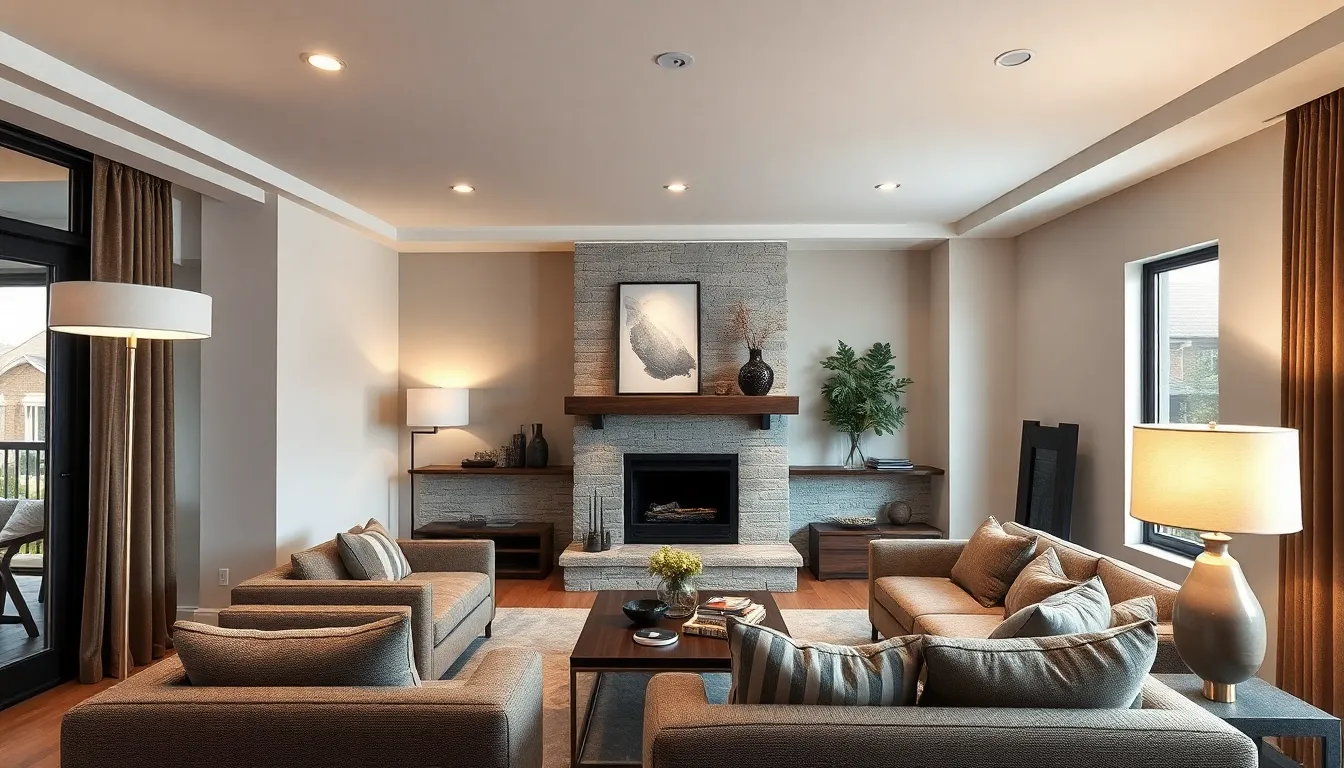
Strategic lighting transforms neutral living rooms from flat, monotonous spaces into ever-changing environments with visual depth and warmth. The interplay of different lighting layers creates the foundation for a welcoming atmosphere that enhances your carefully curated neutral palette.
Install Ambient Ceiling Fixtures
Ambient ceiling fixtures provide the essential foundation lighting that sets the overall mood in your neutral living room. Soft overhead lights create a welcoming base layer that illuminates the entire space evenly. Recessed lighting offers a clean, modern approach that doesn’t compete with your neutral design elements while delivering consistent illumination throughout the room.
We recommend choosing fixtures with warm light temperatures between 2700K and 3000K to complement your neutral color scheme. Ceiling-mounted fixtures work particularly well in rooms with higher ceilings, while flush-mount options suit spaces with standard ceiling heights. Dimmer switches allow you to adjust the ambient lighting intensity to match different times of day and activities.
Incorporate Task Lighting Options
Task lighting enhances functionality while adding crucial layers to your neutral decor scheme. Floor lamps positioned near seating areas provide focused illumination for reading and create intimate conversation zones. Table lamps on side tables or console tables offer convenient lighting for exact workspaces and activities.
Strategic placement of task lighting prevents your neutral living room from feeling flat by creating pools of light at different heights. We suggest using lampshades in neutral tones like cream, linen, or soft white to maintain cohesion with your overall palette. Adjustable task lights give you flexibility to direct illumination exactly where you need it most.
Use Accent Lighting for Atmosphere
Accent lighting creates dramatic atmosphere and highlights exact features within your neutral living space. Wall sconces draw attention to architectural details and artwork while adding vertical interest to your lighting design. Track lights offer versatility in highlighting textured furnishings, stone features, or wood accents that define your neutral aesthetic.
Picture lights specifically illuminate artwork and create focal points that prevent monotony in neutral color schemes. We recommend positioning accent lights to emphasize the mixed materials and textures that enrich your neutral space, such as highlighting a stone fireplace or showcasing wood furniture pieces. The careful interplay of ambient, task, and accent lighting ensures your neutral living room maintains both style and functionality while creating visual dimension throughout the space.
Incorporate Natural Elements for Warmth
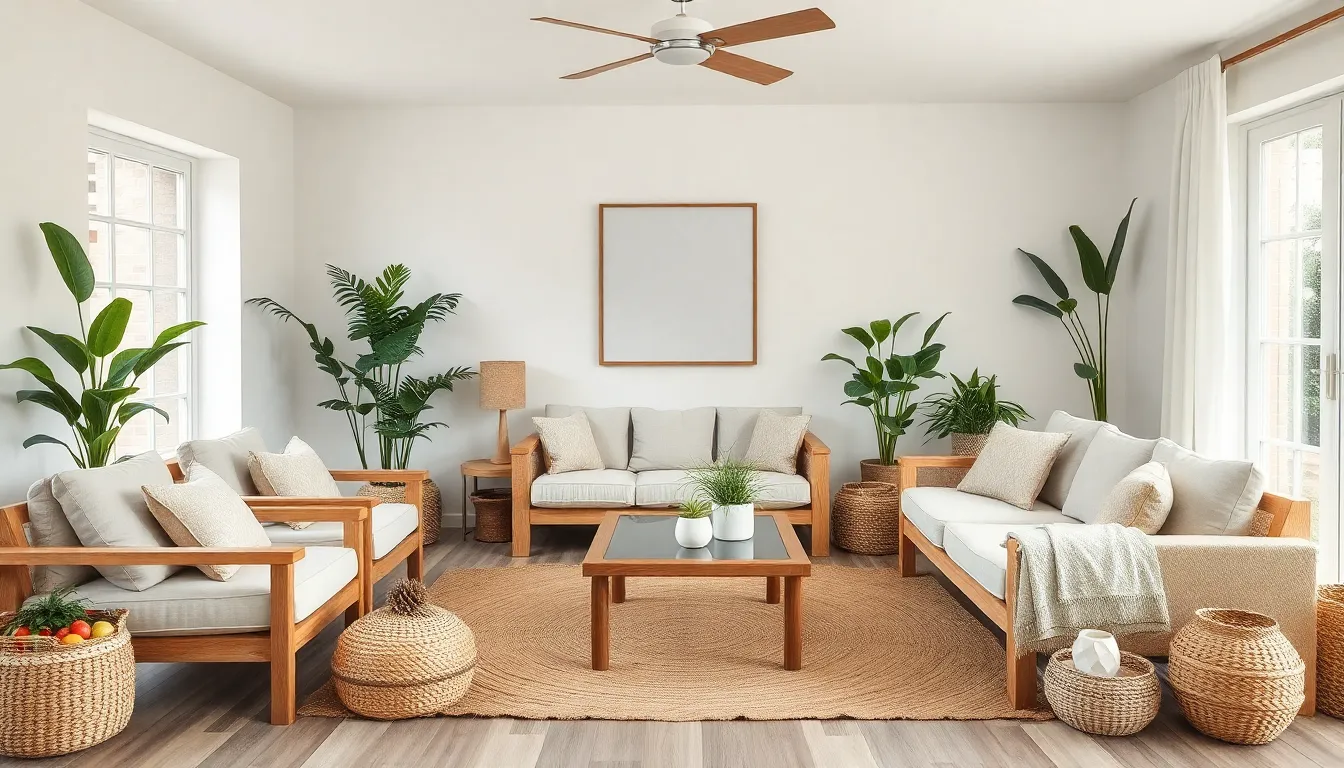
Building on our foundation of versatile furniture and strategic lighting, we’ll now explore how natural elements transform neutral living rooms into warm, inviting sanctuaries. Natural materials like wood, stone, and brick add essential depth and texture that prevents neutral spaces from feeling cold or sterile.
Display Indoor Plants and Greenery
Plants introduce vibrant life and natural beauty to our neutral living rooms while maintaining the serene aesthetic we’ve carefully crafted. We recommend selecting low maintenance varieties like snake plants, pothos, or fiddle leaf figs that thrive indoors without requiring constant attention. Grouping plants of varying heights creates visual interest, while large floor plants such as monstera or rubber trees serve as stunning focal points in corners or beside furniture.
Strategic placement of greenery near windows maximizes natural light exposure and creates beautiful silhouettes against neutral backdrops. We suggest using natural planters made from woven baskets, ceramic pots in cream or terracotta, or wooden planters that complement our existing neutral palette. Hanging plants like ivy or string of pearls add vertical dimension and draw the eye upward, making rooms feel more spacious and ever-changing.
Add Organic Shapes and Materials
Rounded furniture pieces and curved accessories soften the linear elements typically found in neutral living rooms. We recommend incorporating circular coffee tables, oval ottomans, or curved accent chairs that create flowing movement throughout the space. Natural rock formations or sculptural pieces made from driftwood serve as conversation starters while maintaining the organic aesthetic.
Woven elements bring tactile warmth that perfectly complements neutral color schemes. Rattan furniture pieces like accent chairs or side tables introduce natural texture without overwhelming the space. We suggest adding sculptural bowls made from natural materials, organic shaped vases, or smooth river rocks displayed on coffee tables or shelves. These organic materials create visual contrast against smooth surfaces while staying true to the neutral living room concept.
Include Natural Fiber Accessories
Jute and sisal rugs anchor our neutral living rooms while providing essential texture underfoot. We recommend layering these natural fiber rugs over hardwood or tile floors to define seating areas and add warmth. Woven baskets serve dual purposes as both storage answers and decorative elements, helping maintain the clutter free aesthetic while introducing natural texture.
Linen throw pillows in cream, beige, or soft gray tones enhance comfort while reinforcing our neutral palette. We suggest mixing different natural fiber textures like chunky knit throws, hemp cushion covers, or cotton waffle weave blankets to create depth and visual interest. Natural fiber window treatments such as bamboo blinds or linen curtains filter light beautifully while maintaining the organic feel throughout our neutral living space.
Style With Carefully Chosen Accessories

Accessorizing your neutral living room becomes an art form when you select pieces that enhance rather than compete with your carefully curated palette. We’ll focus on three key accessory categories that transform your space from simple to sophisticated.
Select Neutral Throw Pillows and Blankets
Throw pillows in neutral tones like beige, cream, and gray instantly add comfort while maintaining your room’s cohesive aesthetic. We recommend choosing pillows made from soft materials such as linen or suede to introduce subtle textural variation without disrupting your color scheme.
Layering different fabric textures creates visual depth that prevents your neutral palette from appearing flat. Mix velvet cushions with linen throw pillows to achieve this sophisticated contrast, or combine smooth cotton covers with nubby boucle textures for added interest.
Cable knit blankets bring both warmth and visual texture to your seating arrangements. We suggest draping these cozy accessories over your sofa arm or folding them neatly in a basket for easy access during cooler evenings.
Wool and sheepskin rugs provide additional warmth while introducing natural fiber elements that complement your neutral foundation. Position these textural accessories strategically near seating areas to create inviting zones that encourage relaxation and conversation.
Display Minimalist Artwork
Minimalist artwork adds visual interest without overwhelming your carefully balanced neutral space. We recommend selecting pieces with subtle patterns or abstract designs that complement rather than compete with your existing color palette.
Choosing artwork in muted tones ensures your wall decor enhances your neutral living room’s serene atmosphere. Look for pieces featuring soft grays, warm beiges, or crisp whites that echo your room’s existing color story while providing gentle focal points.
Gallery walls featuring multiple small pieces create visual impact while maintaining the minimalist aesthetic. We suggest grouping artwork in odd numbers and varying the frame sizes slightly to add subtle visual rhythm without creating chaos.
Room dividers with subtle designs can break up larger spaces while serving as functional art pieces. These accessories work particularly well in open concept homes where you want to define different areas without sacrificing your neutral living room’s flowing aesthetic.
Add Subtle Metallic Accents
Metallic accents in brass, gold, or silver introduce subtle glamour while maintaining your neutral room’s sophisticated appeal. We recommend incorporating these elements through lighting fixtures, vases, or decorative items that catch and reflect light beautifully.
Brass accents bring warmth that complements beige and cream color schemes particularly well. Consider brass table lamps, picture frames, or decorative bowls to add this rich metallic tone without overwhelming your neutral palette.
Mixed metal finishes create contemporary appeal when balanced thoughtfully throughout your space. We suggest limiting yourself to two or three metallic tones and distributing them evenly to maintain visual harmony while adding sophisticated shine.
Terracotta and ceramic decor pieces provide earthy metallic alternatives that feel more organic than traditional metals. These accessories bridge the gap between your neutral colors and metallic accents, creating a cohesive look that feels both modern and timeless.
Define Spaces With Area Rugs and Textiles
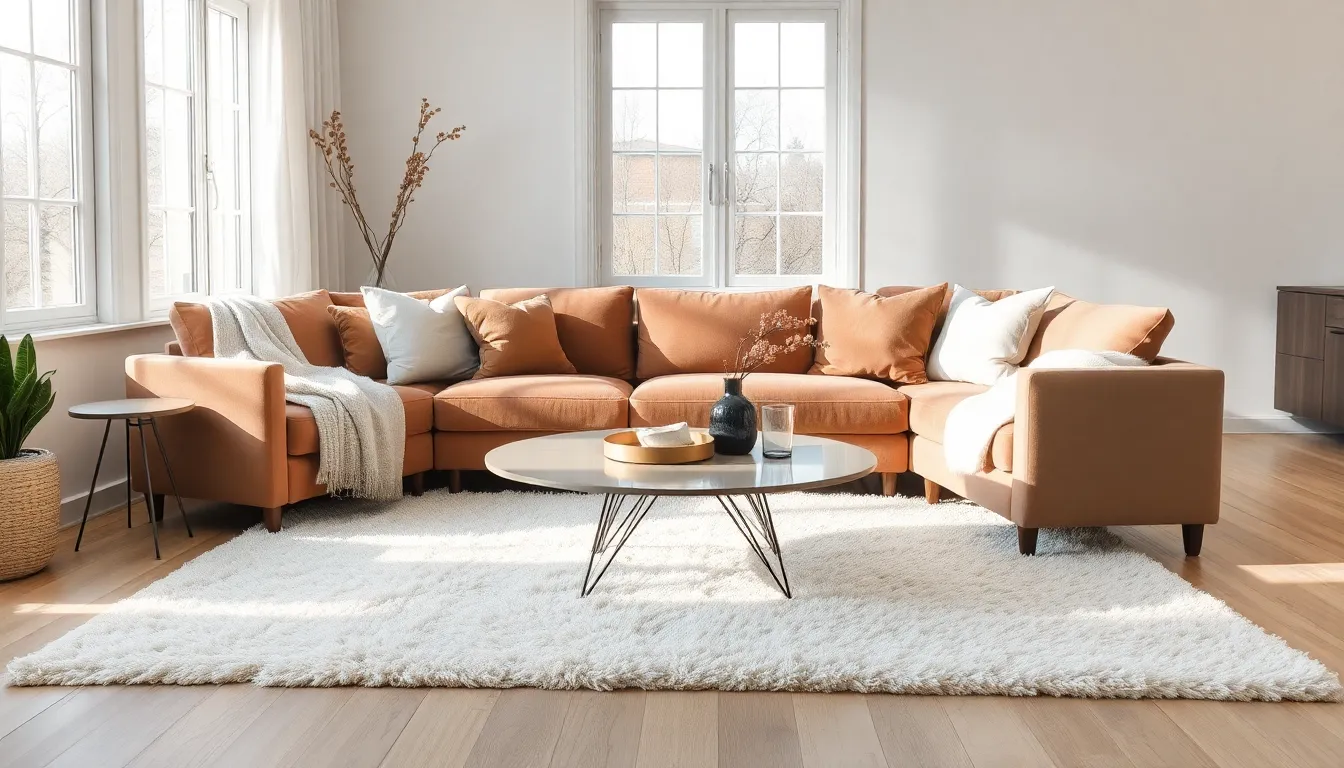
Area rugs and textiles become powerful tools for organizing your neutral living room while maintaining the cohesive aesthetic we’ve been building. We can transform open layouts into functional zones while adding layers of comfort and visual interest.
Choose Neutral Patterned Rugs
Broken-line patterns offer subtle visual interest without disrupting your neutral palette’s tranquil flow. These understated designs create movement and texture while maintaining the sophisticated look we’re cultivating. Faux cowhide rugs introduce organic shapes that complement the natural elements we’ve already incorporated into our space.
Geometric patterns in muted tones work beautifully to anchor seating areas and define conversation zones. We recommend selecting rugs with cream, beige, or soft gray patterns that echo the neutral tones already present in your furniture and accessories. Abstract designs with gentle curves soften the angular lines of modern furniture while maintaining visual cohesion.
Scale matters when choosing patterned rugs for neutral living rooms. Larger patterns suit spacious areas and create bold focal points, while smaller repeating motifs work well in intimate seating areas. We suggest ensuring your rug extends at least 18 inches beyond your sofa on all sides to properly define the space.
Layer Different Textile Elements
Linen throws draped over velvet sofas create compelling textural contrasts that elevate your neutral palette. This layering technique adds depth and invites touch while maintaining the sophisticated look we’ve established. Cable-knit blankets introduce cozy warmth and visual texture that complements both modern and traditional furniture pieces.
Suede cushions paired with sheepskin rugs offer luxurious tactile experiences that transform simple seating into comfortable retreats. We can mix these different materials strategically to create zones of comfort while maintaining our cohesive neutral aesthetic. Natural fiber elements like jute and sisal continue the organic theme we’ve woven throughout the space.
Varying pile heights in rugs and textiles creates subtle visual layers that catch light differently throughout the day. Smooth materials like silk or satin pillows provide elegant contrast against rougher textures like wool or linen. We recommend limiting ourselves to three to four different textures per seating area to avoid overwhelming the peaceful neutral atmosphere.
Create Zones Within Open Floor Plans
Strategic rug placement transforms large open areas into intimate conversation spaces and functional work zones. We position area rugs to define exact activities like reading nooks, entertainment areas, or dining spaces within the larger room. Each rug becomes an anchor point that organizes furniture and creates natural boundaries.
Furniture arrangement works with your rugs to reinforce these distinct zones while maintaining visual flow between areas. We recommend aligning sofa fronts with rug edges and ensuring coffee tables sit entirely on the rug surface. This creates clearly defined spaces that feel intentional and organized rather than scattered.
Lighting reinforces the zones we’ve created with rugs and furniture placement. Table lamps positioned on side tables within each rug zone provide task lighting that makes each area feel complete and functional. We can use different light temperatures subtly to distinguish zones while maintaining the warm, cohesive atmosphere that makes neutral living rooms so inviting.
Maintain Balance With Proper Scale and Proportion
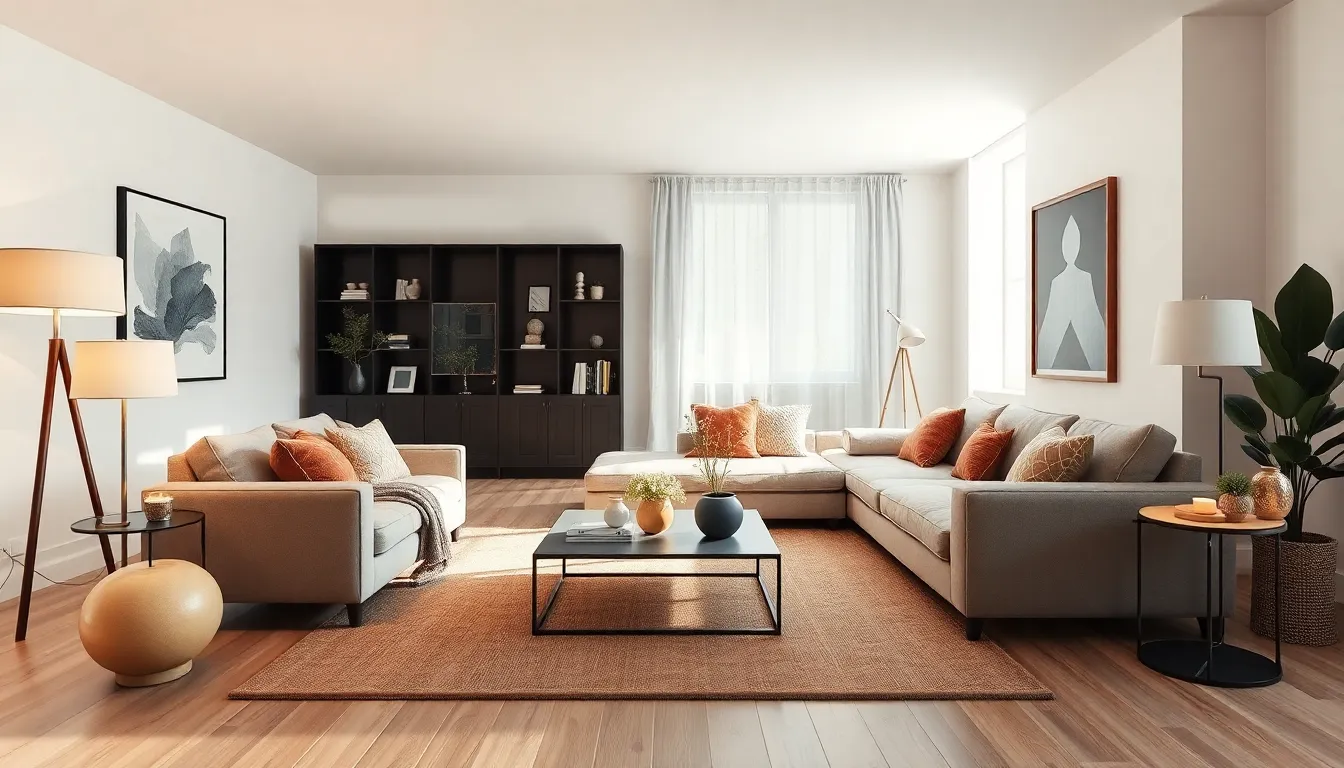
Scale and proportion form the foundation of any successful neutral living room design. Getting these elements right ensures your space feels harmonious and inviting rather than awkward or overwhelming.
Arrange Furniture for Flow
Furniture arrangement should prioritize movement and conversation to create a truly functional neutral living room. We recommend placing seating pieces in conversational groupings that naturally encourage social interaction while maintaining clear pathways throughout the space.
Position your sofa and chairs to face each other or create an L-shaped configuration for optimal conversation flow. This arrangement allows family members and guests to engage comfortably without straining to see or hear one another.
Leave at least 3 feet of walking space between major furniture pieces to ensure smooth navigation. Traffic patterns become especially important in neutral rooms where subtle color variations make spatial boundaries less obvious than in high-contrast spaces.
Use area rugs and strategic lighting to define separate activity zones without disrupting overall room flow. A reading nook or entertainment area can coexist beautifully within your neutral palette when properly delineated through thoughtful placement.
Mix Different Sized Accessories
Layering accessories of varying scales prevents your neutral living room from feeling flat or monotonous. We suggest combining larger statement pieces like oversized floor lamps or large-scale artwork with medium and small decorative objects to create visual rhythm.
Start with one or two large anchor pieces such as a substantial table lamp or dramatic wall art. These elements establish focal points that draw the eye and provide visual weight to balance your neutral furniture pieces.
Add medium-sized accessories like ceramic vases, books, or decorative bowls to bridge the gap between large and small elements. This middle layer creates depth and prevents jarring transitions between dramatically different scales.
Include smaller details such as candles, small sculptures, or decorative objects to complete your layered look. These finishing touches add personality and visual interest without overwhelming your carefully curated neutral aesthetic.
Create Visual Weight Distribution
Balancing visual weight ensures your neutral living room feels stable and well-proportioned rather than lopsided. We achieve this by distributing heavy and light elements strategically throughout the space to create equilibrium.
Position substantial pieces like sofas or bookcases opposite lighter elements such as glass tables or open shelving units. This creates a sense of balance that prevents any single area from feeling too heavy or too sparse.
Incorporate accent colors in black, warm metals, or subtle soft hues to anchor your neutral palette and add visual weight where needed. These strategic color touches help distribute attention evenly across the room.
Mix textures including wood, stone, bouclé, and wool to add depth and prevent your neutral space from appearing flat or sterile. Different textures catch and reflect light uniquely, creating natural visual weight variations that enhance the overall balance of your living room.
Conclusion
Neutral living rooms offer endless possibilities for creating spaces that feel both sophisticated and welcoming. We’ve explored how layering textures materials and strategic lighting can transform simple color palettes into ever-changing environments that reflect your personal style.
The beauty of neutral design lies in its adaptability. By mastering the fundamentals we’ve discussed—from balancing warm and cool tones to incorporating natural elements and choosing versatile furniture—you’ll create a foundation that evolves with your changing needs and preferences.
Remember that successful neutral living rooms aren’t about playing it safe but about making thoughtful design choices. With careful attention to scale proportion and the strategic use of accessories you’ll achieve a space that’s both timeless and uniquely yours.
Frequently Asked Questions
What makes neutral living rooms so appealing and timeless?
Neutral living rooms offer timeless elegance and versatility through warm beiges, soft grays, crisp whites, and earthy tones. They create welcoming, relaxing environments that allow for personal expression through textures and accents. The flexible design enables easy seasonal updates without complete overhauls, making them both practical and stylish for any home.
How do I create a cohesive neutral color foundation?
Start by layering different neutral tones for depth and visual interest. Use warm neutrals like beige, cream, and taupe for inviting atmospheres, balanced with cool shades like gray and charcoal for sophistication. Follow the 60-30-10 rule to distribute light and dark elements effectively while maintaining visual cohesion.
What textures work best in neutral living rooms?
Layer different fabric textures like velvet cushions with linen throw pillows to add depth without overwhelming the palette. Incorporate natural wood accents through furniture and architectural details for warmth. Stone or concrete features introduce earthy textures and can serve as striking focal points or subtle accessories.
What furniture pieces should I choose for a neutral living room?
Invest in quality neutral sofas in white, beige, or gray as anchor points that allow for colorful accessory experimentation. Choose multi-functional storage solutions like storage ottomans and console tables to maintain an uncluttered aesthetic. Select timeless coffee tables made from natural materials like wood or stone for lasting style.
How important is lighting in neutral living room design?
Strategic lighting transforms neutral rooms from flat spaces into dynamic environments with visual depth and warmth. Use ambient ceiling fixtures with warm light temperatures (2700K-3000K), task lighting for functionality, and accent lighting to highlight features. The interplay of all three lighting types maintains both style and functionality.
How can I incorporate natural elements to add warmth?
Use materials like wood, stone, and brick for depth and texture. Add indoor plants like snake plants and pothos for vibrant life, grouping them at varying heights in natural planters. Include organic shapes through rounded furniture and woven elements, plus natural fiber accessories like jute rugs and linen pillows.
What accessories work best in neutral living rooms?
Select neutral throw pillows and blankets in soft materials for comfort and visual depth. Choose minimalist artwork in muted tones for gentle focal points. Add subtle metallic accents in brass, gold, or silver for glamour and warmth, but maintain balance to ensure a cohesive, non-overwhelming look.
How do I use rugs and textiles effectively?
Choose neutral patterned rugs with geometric designs in muted tones to define conversation zones. Ensure rugs extend at least 18 inches beyond sofas for proper scale. Layer different textile elements like linen throws and cable-knit blankets, varying pile heights to catch light differently throughout the day.
What role does scale and proportion play in neutral design?
Proper scale and proportion ensure harmony in neutral spaces. Arrange furniture to promote flow and conversation while maintaining clear pathways. Mix different sized accessories to create visual rhythm, using larger anchor pieces with medium and small decorative objects for balanced visual weight distribution throughout the room.

